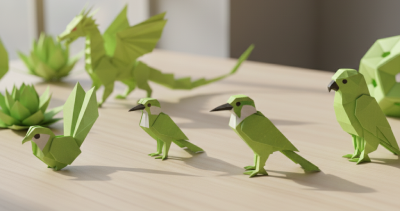
Learning AI is like learning Origami.
You start with a flat sheet of paper—full of potential but shapeless.
Through careful, deliberate folds (training), that paper transforms into something functional and beautiful.
Each fold matters.
Fold incorrectly early on, and your crane won’t fly…
Train on poor data or poorly written prompts, and your AI won’t perform.
The Path to AI Mastery:
Training (Learning the Folds)
Like a beginner studying basic origami patterns—the valley fold, the mountain fold, the petal fold—you start by understanding fundamental techniques. You practice the same crane dozens of times. Some attempts are lopsided. Some tear. But each iteration teaches you where pressure matters, where precision counts. This is training: repetitive, sometimes frustrating, but building muscle memory and understanding.
In AI: You start by experimenting and observing what works. You ask Copilot to summarise a document and notice it misses key points—so you learn to give it clearer instructions. You try generating code and realise vague requests produce vague results. Each interaction teaches you how to communicate better, what level of detail matters, and when to break big requests into smaller steps. Like learning that crisp folds create sharp edges, you discover that specific prompts create better outputs.
Adoption (Folding for Others)
Now you can make cranes reliably. You begin teaching friends, folding at parties, creating pieces for specific purposes. This is like adopting low-code agents—taking proven patterns and applying them to real problems. You’re not inventing new origami forms yet; you’re skillfully deploying what works. The magic is in knowing which fold solves which problem, and adapting your technique to different paper types (different business contexts).
In AI: You start using Copilot in your daily work—drafting emails, analysing Excel data, summarising Teams meetings. You build a Copilot Studio agent that answers HR questions using your company’s policies. You’re not building AI from scratch; you’re taking existing tools and shaping them to your needs. The skill is knowing when Copilot in Word helps with writing, when Copilot in Excel reveals insights in data, and how to customise agents for your team’s specific questions. Different tools for different jobs, just like different origami patterns for different purposes.
Delivery (The Working Creation)
Your origami box actually holds jewelry. Your paper boat floats. Your AI agent actually routes customer inquiries. The creation serves its purpose in the real world. You’ve moved beyond practice into production—delivering value, not just demonstrations.
In AI: Your custom Copilot agent handles employee questions about benefits and holiday policies, freeing up HR for complex cases. Your automated workflow in Power Automate processes invoices while you sleep. Your team uses the agent you built every single day, and they depend on it. It’s not a demo or an experiment anymore—it’s part of how work gets done. You monitor how people use it, gather feedback, and refine it based on real needs, just like adjusting an origami design based on how people actually use it.
True Mastery (Creating New Forms)
The master doesn’t just follow instructions. They see a flat sheet and envision forms that don’t yet exist. They understand paper’s grain, tension, and limits so deeply they can innovate. Similarly, AI mastery means understanding models deeply enough to architect novel solutions, to know when to break the patterns, to create agents that solve problems in ways no template anticipated.
In AI: You design solutions that connect multiple agents working together—one Copilot agent gathers customer information, another checks inventory, a third generates personalised recommendations. You see a business challenge and immediately envision how AI could transform it, knowing what’s realistic and what’s not. You teach others not just how to use the tools, but how to think differently about problems when AI is available. Like an origami master who sees a sheet of paper and envisions a dragon no one’s folded before, you look at business processes and imagine solutions that don’t exist yet—then build them.

Start your journey…
Because every master started with their first awkward fold. Without training, that sheet of paper remains flat and unused—full of potential but delivering nothing. Each fold you learn, each technique you practise, transforms what’s possible. The journey from that first lopsided crane to creating forms others admire doesn’t happen by chance—it happens through deliberate practice, patient learning, and the courage to make that first fold. Start your AI training today, because the only way to reach mastery is to begin folding.
Get Started